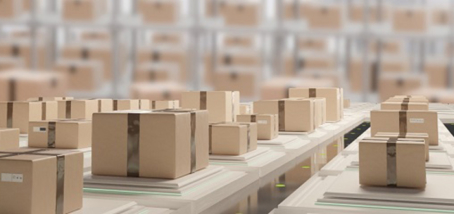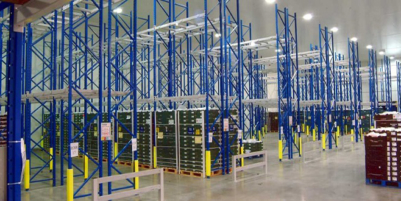-
ROSSLARE EUROPORT TARGETS HEALTH & SAFETY WITH CAMERA TELEMATICS PARTNERSHIP - 2 days ago
-
Landmark Study Reveals Wearable Robotics Significantly Boost Safety and Efficiency in Industrial Environments - July 24, 2024
-
Visku Tackle The Retail Seasonality Challenge One Pallet At A Time - July 22, 2024
-
KAMMAC AND BERGEN LOGISTICS STRENGTHEN FASHION & LIFESTYLE SERVICES IN THE UK - July 19, 2024
-
TENTBOX EXTENDS PARTNERSHIP WITH ARROWXL TO SUPPORT INCREASING DEMAND - July 17, 2024
-
The Perfume Shop improves customer journeys while driving profitability in partnership with Scurri - July 17, 2024
-
ZEROMISSION SECURES £2.3M ($3M) INVESTMENT TO ACCELERATE ELECTRIC FLEETS - July 16, 2024
-
BCMPA CELEBRATES SUCCESS OF 2024 CONFERENCE - July 15, 2024
-
Best of the Best: Jungheinrich Celebrates Triple International Award Win - July 12, 2024
-
GOPLASTICPALLETS.COM CALLS ON NEW CHANCELLOR RACHEL REEVES TO CONSIDER PLASTIC PACKAGING TAX REFORM - July 10, 2024
Ken Fleming, President of Logistyx Technologies discusses how ecommerce supply chains can become more sustainable

As physical retail went on hold during the Covid-19 pandemic, many ecommerce verticals saw order volumes soar. However, there continue to be concerns about the environmental impact of ecommerce supply chains, and consumers will undoubtedly prefer to make their purchases from brands that have a sustainable business model.
Sustainability has many dimensions, from choice of raw materials and factory locations to manufacturing, distribution and recycling policies. For ecommerce brands that ship parcels, however, two primary concerns are how goods are transported and how they are packaged.
Transportation efficiency – go slow to go green
With regards to transportation, sustainability can be addressed by prioritising shipping methods that minimise the impact on the environment and also by consolidating shipments.
In the ecommerce space, same-day and even 1-hour delivery windows are widely believed to be attractive to customers. Yet we are starting to see a growing demand for slower logistics services that have less environmental impact.
Consumers are realising that faster doesn’t always equal better – and definitely not greener. They are asking themselves, ‘do I really need this tomorrow?’ Of course, shipping mode has a major influence on carbon footprints and slower delivery tends to be more environmentally friendly. For instance, companies should prioritise road rather than air transport where applicable. And when they choose road, they should operate fully filled vans – rather than sending half empty vehicles in order to meet fast delivery promises.
When transporting by road, it’s also important to explore using courier services, particularly in larger cities. For example, we’ve seen instances where companies will ship packages via FedEx or UPS to an address just down the street simply because it allows them to take advantage of the parcel tracking technology those carriers offer. However, if the same organisation uses a courier or messenger, the environmental impact is much less. It’s important for companies to have a wide choice of shipping options by partnering with multiple carriers and couriers and by using technology to help decide which is appropriate in terms of cost, speed of delivery, reliability and sustainability.
The beauty of consolidation
By consolidating shipments that are going to the same place, you can reduce corrugation and packing materials, which feels like a ‘no brainer.’ However, while it sounds simple, it can create logistical and administration challenges if you are shipping thousands of parcels every day using multiple different carriers. Thankfully, supply chain technology has advanced to the point where transportation management software can make it easy to identify and automatically process and consolidate shipments that are going to the same destination – as well as selecting the ‘right’ way to ship any particular package from a range of carriers and couriers based on a variety of key metrics.
In this context, the ‘same place’ can vary, of course. It might involve a B2B distributor sending multiple orders to the same company – or to different recipients within the same company, where the shipments can be consolidated, and the orders dispersed to different employees upon receipt.
Alternatively, consolidation can be applied to cross-border shipping to a country in which multiple customers are awaiting orders. All shipments to the country are labelled and sent in one carton to an in-country carrier depot to go through customs as a single transaction; they can later get broken up into individual shipments for domestic distribution. Again, technology such as a multi-carrier shipping solution can help customers address this opportunity efficiently with break/bulk shipping and administration capabilities.
Reduce unnecessary packaging to improve sustainability
Cutting waste by reducing packaging depends on two factors: the packaging material itself and the amount of ‘air’ in the shipment. Research by Packaging by Quadient, found that in around 60% of e-commerce deliveries, at least a quarter of the volume is composed of bubble wrap, polystyrene beads or just fresh air. Thankfully, we are seeing plastic packaging and filling materials increasingly replaced with recycled and/or recyclable materials.
At the same time, there has been a reduction in package sizes, since carriers are now charging based on the size of the box as well as the weight. This is helping to make those notorious examples of small packages packed in giant boxes increasingly rare. This not only helps to reduce environmental impact but also to save costs.
Improving sustainability, by ensuring the packaging material can be reused in the ecommerce returns process is a growing trend. But it shouldn’t stop there. For example, shippers are trying to make returning orders easy by placing a pre-prepared returns label in the carton for customers to use if the item needs to be sent back. However, since not all consumers will want to return their purchase, if a company has 20% returns, 80% of pre-printed labels will simply end up in the bin. Why not direct them to a website to click on the ‘return’ button, to initiate the return and print out a .pdf label on a home printer? This ‘greener’ method can significantly reduce waste.
Cut ecommerce returns
Of course, an important issue with regards to returns is that companies should be trying their hardest to reduce the number of goods that come back altogether, both to cut waste and reduce environmental impact. For example, it may be possible to use analytics to reduce avoidable returns by identifying and addressing any weak links in fulfilment, such as carriers that trigger more returns because items are damaged en-route. Data analysis can also help to identify frequently returned products so that brands can consider discontinuing those product lines or only selling them in physical stores.
Improving supply chain sustainability is becoming a priority in ecommerce. Much of the time it is about identifying and making the right choices – such as choosing the most environmentally-friendly shipping mode and carrier partner for a particular order and destination. In a similar way, it is important to give consumers more choice – are they happy to have their parcel arrive a little later knowing that it is doing less harm to the environment? In many instances, technology can be an enabler here by allowing companies to work with more partners and to use automation and data to make sustainable choices.
Ken Fleming is President of Logistyx Technologies, the leader in Transportation Management for parcel shipping, providing an unmatched global multi-carrier network, predictive analytics and full visibility into customer deliveries. Its software boosts parcel shipping efficiencies and other business KPIs for many of the world’s top manufacturers, retailers and logistics providers.

































